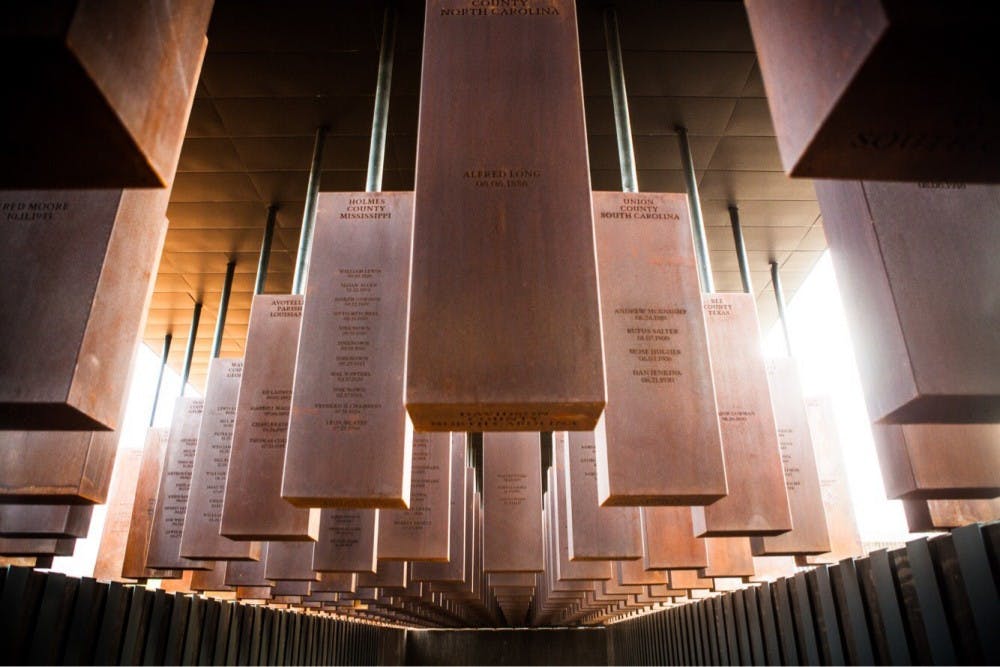Editor's note: This article was updated to correct an error and clarify information. See the correction and clarification at the bottom of the story.
In April 2018, the Equal Justice Initiative unveiled the National Memorial for Peace and Justice, the first national monument in the nation that commemorates the legacy of enslaved African Americans and victims of systemic racial terror.
The site, located in Montgomery, Alabama, includes approximately 800 monuments, each erected to commemorate victims of racial terror lynching and the locations where these horrific crimes occurred.
Four victims of racial terror lynching in Lee County are represented in the memorial.
John Moss was murdered in 1886 by a lynch mob who accused him of murdering a white resident. His cousin, George Hart, was also accused and was sent to jail in anticipation of a trial. When the news broke that he was projected to be cleared of all charges, a white mob kidnapped him from the Opelika jail and hanged him at the same tree as John Moss.
Samuel Harris was shot by a mob of 125 white men in 1902 for unsubstantiated claims of attempted robbery and assault of two white women.
Charles Humphries was shot by over 40 white men for being accused of assaulting a white woman.
No one was ever held accountable.
This information is revealed by over 500 newspaper articles, researched and located by Ashley Brown and Olivia Nichols, co-founders of the Lee County Remembrance Project and doctoral students at Auburn University.
The Lee County Remembrance Project has partnered with the Equal Justice Initiative and is working with community leaders to bring a historical marker identical to the one at the National Memorial for Peace and Justice to Lee County to forever commemorate the legacies of Moss, Hart, Humphries and Harris.
The purpose of this partnership is to engage the community in conversation to address the history and legacy of racial terror and injustice in Lee County, Nichols said. This partnership seeks to address the past and bring the stories of the four Lee County victims to life.
“We have to talk about it if we want an equal society,” said Patricia Butts, executive director of the Lee County Literacy Coalition.
A soil collection ceremony recognizing the history of racial terror in Lee County was supposed to be held at Greater Peace Baptist Church in Opelika on March 16. Due to the COVID-19 pandemic, this event has been pushed back to fall 2020, Nichols said.
While the soil collection ceremony has been postponed, Brown and Nichols said that community engagement efforts are still going strong.
Through the community engagement process, the organization seeks to educate the public about Lee County's history and create discussion about the narratives and the resulting trauma in a collaborative and intentional way, Nichols said.
The Remembrance Project begins this process by establishing relationships with community leaders before moving forward with initiatives to obtain community support. According to Nichols, the organization has given about 23 presentations in places like classrooms and community groups to build overarching support.
The Remembrance Project is sponsoring a high school essay contest for seniors in Lee County to be paired with the historical marker installation. This is an opportunity for a student to process and better understand the difficult parts of Lee County's history and for the Lee County Remembrance Project to continue to spread education and awareness of racial injustice, Brown said.
Brown said the inspiration for the contest came from realizing through other community outreach projects that many students lack awareness of these issues.
The winner of this essay contest will be announced at the site installation ceremony and will receive a $5,000 scholarship.
The organization continues to bring recognition to Lee County's tragic history, Brown said. Butts noted that acknowledging the things that happened in the past is a way to ensure people don’t look past it or bury it.
“If we don’t confront history, it will repeat itself," Butts said.
Correction:
- A previous version of this story incorrectly stated that George Hart never had a trial. It should have stated that Hart was housed in the Opelika jail in anticipation for his trial date. When it was expected that Hart was going to be cleared of all charges, a white mob kidnapped him from the Opelika jail and hanged him, according to Brown and Nichols. We sincerely regret the error and have updated the story with the correction.
Clarification:
- A previous version of this story failed to clarify the racial demographics of those who participated in racial terror lynching. The mobs who engaged in the racial terror lynching of four black men were comprised of white people, according to Brown and Nichols. The four black men who were racially terrorized and lynched were all accused of afflicting some type of damage on white people. We sincerely regret the error and have clarified the article to contextualize the information.
Do you like this story? The Plainsman doesn't accept money from tuition or student fees, and we don't charge a subscription fee. But you can donate to support The Plainsman.





